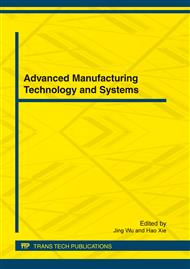[1]
Raja,Vinesh, Fernandes, Kiran J. Reverse engineering: an industrial perspective. British library Cataloguing in Publication Data.2008:05-120.
Google Scholar
[2]
Sanfeng Dong, Xiaoqing Wu, Lanfang Feng. The reverse design of automotive interior parts Based on reverse engineering. Machinery Design & Manufacture in Chinese. 2009.09:30-31.
Google Scholar
[3]
Jung H B, Kim K.A new parameterization method for NURBS surface interpolation , Int J Adv M ANUF Technol,2000.16:784-790.
Google Scholar
[4]
Zhengru Wang, Jin Liang, Lizhong Wang. Study on the CAD modeling of the automobile panels based on reverse engineering. Machinery Design & Manufacture in Chinese. 2010.07:106-108.
Google Scholar
[5]
Aoyama H,Suzuki Y. Autonomous Measurement of Physical Model Shape for Reverse Engineering. Jof Manufacturing System,2001,19(6);375-382.
DOI: 10.1016/s0278-6125(01)80009-1
Google Scholar
[6]
Wickers G W , Bradley C. Curve and surface matching through circular arc interpo- lation. Computer Industry, 1992.19: 329-337.
Google Scholar
[7]
E. Bagci. Reverse engineering applications for recovery of broken or worn parts and re-manufacturing: Three case studies. Advances in Engineering Software 40 (2009) 407-418.
DOI: 10.1016/j.advengsoft.2008.07.003
Google Scholar
[8]
Zhenkai Liu,Lihui Wang, Bingheng Lu. Integrating cross-sectional imaging based reverse engineering with rapid prototyping. Comput Ind 2006; 57(2):31-40.
Google Scholar
[9]
Zhong wei Y. Direct integration of reverse engineering and rapid prototyping based on the properties of NURBS or B-spline. Precis Eng 2005: 28(3):293-301.
DOI: 10.1016/j.precisioneng.2003.11.004
Google Scholar
[10]
Budak I. Development of a system for reverse engineering based design of complex shapes with emphasis on data-point pre-processing. In: Proceedings of 11th international CIRP life cycle engineering seminar product life cycle quality management issues Belgrade, 2004. p.223–9.
Google Scholar


